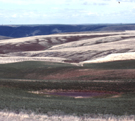Holocene Temperatures and Sea Level Changes
Taylor, George H. Holocene Temperatures and Sea Level Changes. Western Institute for Study of the Environment, December, 2007
George H. Taylor is a Certified Consulting Meteorologist and Director of the Oregon Climate Service, Oregon State University.
Full text [here]
Selected excerpts:
At the end of the last Ice Age, global temperatures increased significantly and ushered in an interglacial period known as the Holocene. According to Pielou (1991), the interglacial is now more than half over, with temperatures having peaked about 10,000 years ago.
On the basis of a variety of “proxy” indicators (parameters which allow estimates of climate change), there is much evidence for the early Holocene peak…
1. Based on studies of latitudinal displacements of terrestrial vegetation (Bernabo and Webb, 1977; Wijmstra, 1978; Davis et al., 1980; Ritchie et al., 1983; Overpeck, 1985) and vertical displacements of alpine plants (Kearney and Luckman, 1983) and mountain glaciers (Hope et al., 1976; Porter and Orombelli, 1985), it has been concluded (Webb et al., 1987; COHMAP, 1988) that mean annual temperatures in the Midwestern United States were about 2 °C warmer 8,000 years ago than temperatures of the past few decades (Bartlein et al., 1984; Webb, 1985).
2. At about the same time, summer temperatures in Europe were 2 °C warmer than present (Huntley and Prentice, 1988), as was the case in New Guinea (Hope et al., 1976), and temperatures in the Alps were as much as 4 °C warmer (Porter and Orombelli, 1985; Huntley and Prentice, 1988).
3. In the Russian Far East, temperatures are also reported to have been from 2 °C (Velitchko and Klimanov, 1990) to as much as 4-6 °C (Korotky et al., 1988) higher than at present; while the mean annual temperature of the Kuroshio Current between 22 and 35 °N was 6 °C warmer (Taira, 1975), and the southern boundary of the Pacific boreal region was positioned 700 to 800 km north of its present location (Lutaenko, 1993)…
This warmer period has customarily been referred to as the Holocene Climatic Optimum (MacCracken et al., 1990; Ciaia et al., 1992; Lutaenko, 1993; Lambin et al., 1996) because the warmer (and in many cases, wetter) conditions are thought to have been beneficial to society and ecosystems. Further, during this period the world experienced “the rise of human civilization, based on the development of agriculture (Whyte, 1995).”…
After the Ice Age
Pielou, E.C., After the Ice Age: The Return of Life to Glaciated North America. 1991, Univ. Chicago Press.
Review by Mike Dubrasich
The smartest woman in the world is a little old lady who lives on Vancouver Island in British Columbia. Eighty-ish and now retired, Evelyn putters about her garden, does her shopping, and lives her life in relative obscurity. Her neighbors must know and love her, and they must find her to be very bright, but they may not realize just how smart she is.
Evelyn has described herself as a “naturalist,” but she is better known to the scientific world as Dr. E. C. Pielou, the inventor of mathematical ecology.
Mathematical ecology involves the quantification and statistical analysis of natural phenomena. Dr. Pielou’s book, Introduction to Mathematical Ecology (1969), is the bible of the field. It is not a light read. To get the most out of it requires a background in ecology and statistics at the post-graduate level. However, if you wish to measure something in the environment and do not follow Evelyn’s advice on the matter, you are doing it wrong.
Dr. Pielou holds Ph.D. and D.Sc. degrees from the University of London. She has been a professor at the Yale School of Forestry, Dalhousie University, Halifax, and the University of Lethbridge, Alberta, as well as holding a variety of guest lectureship positions all over. In 1984 she was awarded the Lawson Medal of the Canadian Botanical Association and in 1986 she won the Eminent Ecologist Award of the Ecological Society of America. The ESA has also established the E.C. Pielou Award, a competitive award made annually to a graduate student or recent Ph.D. graduate based on overall quality of the student’s scientific contribution to statistical ecology.
Dr. Pielou has written some popular science books, as well as dozens of technical scientific papers. Her books include:
Ecological Diversity (1975)
The Interpretation of Ecological Data: A Primer on Classification and Ordination (1984)
The World of Northern Evergreens (1988)
Biogeography (1992)
A Naturalist’s Guide to the Arctic (1995)
Fresh Water (1998)
The Energy of Nature (2005)
Her most famous (fame is subjective) “pop” book, and one that perhaps has more significance today than when she wrote it, is After the Ice Age: The Return of Life to Glaciated North America (1991).
In After the Ice Age Dr. Pielou describes the ecological changes that have occurred in North America over the last 20,000 years.
We live in a glacial age, something rare in the history of the Earth. Our current glacial age (the Pleistocene) began two million years ago (roughly). The most recent previous glacial age was during the Permian Epoch, 250 million years ago.
